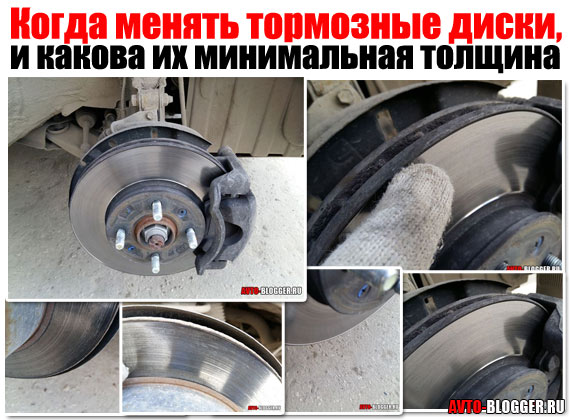
Minimum thickness of brake discs. Change or not
Brake discs and drums, like pads, are consumables. These are perhaps the most intensively used car parts. Their level of deterioration must be monitored and replaced in time. Do not tempt fate and bring the brake system to an emergency state.
As the metal thins, the heating of brake parts increases. As a result, when driving aggressively, it can boil, which will lead to complete failure of the braking system.
The more the surface of the disc is erased, the further the piston in the working cylinder has to move forward in order to press the brake pads.
When the surface is worn too hard, the piston may at some point warp and jam. This can lead to failure of the calipers. In addition, friction will cause the disk to become excessively hot, and if a puddle gets in the way, it can collapse due to a sharp temperature drop. And this is fraught with a serious accident.
It is also possible that there will be a sudden leakage of brake fluid. Then when you press the brake pedal, it just fails. No one needs to explain what a brake failure can lead to.
In urban conditions, the average working life of brake discs is approximately 100 thousand kilometers. Ventilated ones will last longer, but sooner or later they will have to be changed. The service life may be longer or shorter depending on the specific operating conditions, road conditions, weather, material of manufacture, design features of the vehicle and its weight.
Wear is significantly accelerated due to poor-quality pads and, of course, aggressive driving style with frequent hard braking. Some "Schumachers" manage to kill the brake discs after 10-15 thousand kilometers.
However, you need to focus not so much on the mileage, but on the specific condition of the disks.
The following signs may indicate that they are worn out:
- jerking or beating when pressing the brake pedal;
- the pedal is pressed too lightly or fails;
- leaving the car to the side when braking;
- increase in stopping distance;
- strong heating and grinding in the wheels;
- decrease in brake fluid level.
Automakers strictly regulate the wear limit of brake discs. When the thickness reaches the minimum allowable value, they must be replaced.
The nominal and minimum allowable thicknesses are usually stamped on the end face. In addition, there may be special marks by which it is possible to determine the degree of wear, even without having a measuring tool at hand. If the disk is erased to this mark, then it must be replaced.
Many machines have metal plates that rub against the disc when it reaches its wear limit. At the same time, a distinct specific rattle is heard.
Often, wear sensors are also installed in the pads, which, when the minimum allowable thickness is reached, give a corresponding signal to the on-board computer.
Regardless of the presence of marks and sensors, it is worth periodically measuring manually using a caliper or micrometer. it is necessary to diagnose in several places, since wear can be uneven.
There are no specific standards regarding the thickness of brake discs. the correct and minimum allowable thickness may vary from manufacturer to manufacturer. Therefore, you need to check with the service documentation of your car, where the appropriate tolerances are indicated.
During operation, the brake disc is capable of deforming, cracks, irregularities and other defects may appear on it. Their presence is manifested by vibration when the brake pedal is pressed. If the thickness of the disk is sufficient, then in this case it can be sanded (turned). Otherwise, you will have to buy and install a new one.
A high-quality groove can be made using a special machine, which is installed in place of the caliper. The disk itself is not removed from the wheel.
Some craftsmen grind with a grinder, but in this case it is difficult to vouch for the quality. Also, accuracy cannot be guaranteed when using a lathe, when the groove is made relative to its reel, and not to the wheel hub.
After turning, the brake pads must be replaced, otherwise the vibrations and beats during braking will appear again.
To avoid unbalancing the wheels when braking, it is imperative to change both brake discs on the same axle at the same time.
Together with them, it is strongly recommended to replace the brake pads, even if they are not worn out. The fact is that the pads quickly rub against the disc, and when replacing the latter, beats and strong heating may occur due to the mismatch of the surfaces.
In no case do not experiment by increasing the thickness of the disc using welded or screwed pads. Such savings on your own safety will not lead to anything good, and in the worst case, it can cost you your life.
Recall that earlier we wrote about that. When buying new discs (you remember, you need to change a pair on the same axis at once), we recommend that you also grab new brake pads.
Ideally from a single manufacturer. For example, consider a manufacturer of parts for Chinese cars. Mogen brand spare parts undergo scrupulous German control at all stages of production.
